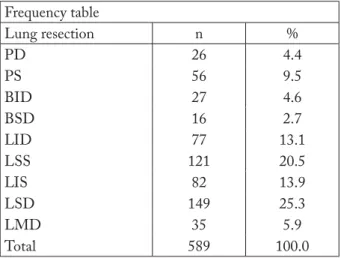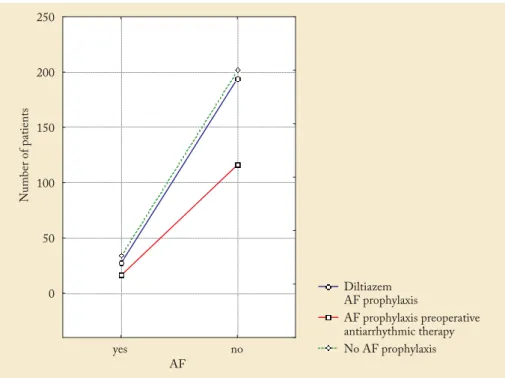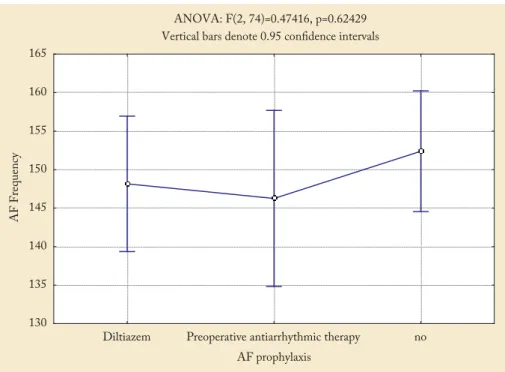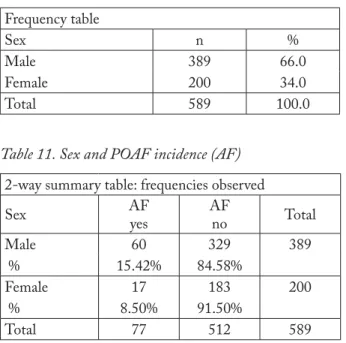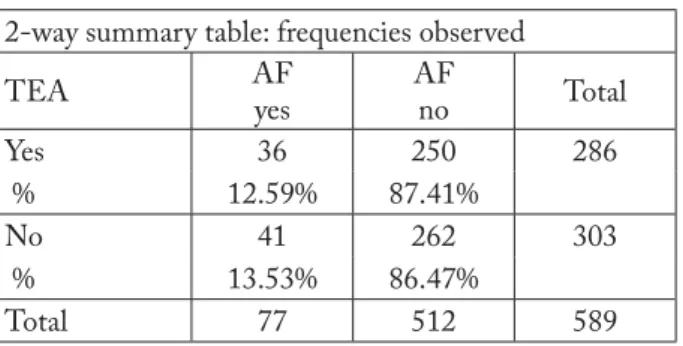POSTOPERATIVE ATRIAL FIBRILLATION
PROPHYLAXIS AND LUNG RESECTION
– OUR EXPERIENCE WITH 608 CONSECUTIVE PATIENTS
Vjekoslav Karadža, Dinko Stančić-Rokotov, Jasna Špiček Macan, Nevenka Hodoba,Nevenka Kolarić and Sanja Sakan
Jordanovac Department of Th oracic Surgery, Zagreb University Hospital Center, Zagreb, Croatia SUMMARY – Postoperative atrial fi brillation is a common complication after lung resection. It is burdened by increased mortality and morbidity, prolonged hospitalization, and higher resource utilization in thoracic surgery patients. Th erefore, some kind of pharmacological prophylaxis is recom-mended. In our patients, diltiazem, a calcium antagonist, is administered. We collected data on all 608 patients having undergone lung resection (no less than lobectomy) between November 2012 and May 2015. Th is period included patients having received diltiazem during their postoperative stay in our Intensive Care Unit and surgical ward, and those that did not receive it. Patients having had atrial fi brillation before the surgery and patients with cardiac pacemaker were excluded from the trial. Other patients were divided into three groups: patients with some kind of antiarrhythmic therapy before and continued after the surgery; patients with diltiazem prophylaxis; and patients without any anti-arrhythmic prophylaxis. Th e data collected were statistically analyzed. We found no statistically signifi cant diff erence in the incidence of postoperative atrial fi brillation among the groups (p<0.05).
Key words: Diltiazem; Atrial fi brillation; Th oracic surgery
Correspondence to: Vjekoslav Karadža, MD, Jordanovac Depart-ment of Th oracic Surgery, Zagreb University Hospital Center, Jor-danovac 104, HR-10000 Zagreb, Croatia
E-mail: [email protected], [email protected] Received November 10, 2015, accepted September 28, 2016
Introduction
According to the literature, postoperative atrial fi -brillation (POAF) (or equivalent supraventricular ar-rhythmia) is a common complication after pulmonary and esophageal surgery, with the incidence between 12% and 44%1,2 . Some risk factors have been
identi-fi ed, correlation with perioperative mortality and mor-bidity has been demonstrated, and prophylactic and therapeutic guidelines have been developed1,2. POAF
is associated with hemodynamic instability, heart fail-ure, thromboembolic events, higher resource utiliza-tion and, possibly, increased mortality1. Th e precise
mechanism of POAF development is not well under-stood1. Th e risk factors include history of smoking,
obesity, advancing age, atrial dilatation, myocardial
ischemia, volume overload, history of heart failure, in-creased adrenergic and vagal tone, and surgical proce-dures associated with local or systemic infl ammation1,2.
Th e extent of pulmonary resection is of importance as a risk factor, with the highest rates of incidence noted after pneumonectomies, extrapleural pneumonecto-mies and lung transplantations2. Lobectomies and
pneumonectomies are recognized as high risk proce-dures with POAF incidence above 15%1. Among
drugs recommended for the prophylaxis of POAF and equivalent postoperative arrhythmias is diltiazem, a calcium antagonist2,3. It has few side eff ects and, with
respect to known contraindications, it is well tolerated, especially in patients with chronic obstructive pulmo-nary disease (COPD)2.
Patients and Methods
Th is observational study was performed at Jordan-ovac Department of Th oracic Surgery, Zagreb Univer-sity Hospital Centre, Zagreb, Croatia. Data from
med-ical records of all patients having undergone pulmo-nary resection procedures with a high risk of POAF1
(lobectomies, bilobectomies and pneumonectomies) between November 2012 and May 2015 were includ-ed in the study. It was the time of introducing diltia-zem for atrial fi brillation (AF) prophylaxis in our pa-tients, thus including patient data before and during the introduction of diltiazem prophylaxis. Th e follow-ing data were collected: patient age, sex, the American
Society of Anesthesiologists Physical Status (ASA status), comorbidity (coronary disease, arterial hyper-tension, other cardiac diseases and arrhythmias, preop-erative chemotherapy, preoppreop-erative irradiation, hypo-/ hyperthyroidism, diabetes mellitus, renal insuffi ciency, alcoholic cirrhosis, concomitant malignancy), relevant preoperative drug therapy, lung resection type (extent, intrapericardial, extrapleural), use/no use of thoracic epidural analgesia (TEA), use/no use of POAF pro-phylaxis (and if, what kind), presence/absence of post-operative fi brillation and equivalent arrhythmia, and the highest ventricular response recorded during POAF. Th e choice of risk factors and collected data was determined by the data available from medical re-cords. All patients had spent at least one night, most of them two or more nights, in the Intensive Care Unit (ICU) before they were admitted to thoracic surgery ward. Patients were divided into three groups: group A included patients with no POAF prophylaxis; group B included patients with diltiazem prophylaxis; and group C included patients with preoperative antiar-rhythmic therapy (mostly beta-blockers, a few propafe-none or amiodarone) that was continued postopera-tively. Diltiazem was included in therapy, if there were no contraindications, on the day of surgery or the fi rst postoperative day (according to clinical circumstances) and continued after transfer from ICU to surgical ward. A patient was included in group B if the 24-hour diltiazem dose was at least 60 mg (usually it was between 60 mg and 240 mg per os divided in 2-4 doses). All patients were treated equally according to the ICU and surgical ward perioperative treatment protocol. All patients gave their informed consent for participation in the study. Statistical analysis and data analysis were done by the licensed STATISTI-CA 6.1 StatSoft Inc. 1983-2003 (serial number AGA304B211928E61) software. Th e sample was pre-sented by descriptive statistics and frequency tables. Correlation between the highest recorded ventricular frequency of AF and other parameters was tested by the analysis of variance (ANOVA) and t-test for inde-pendent samples. Correlation between the incidence of AF and other parameters was presented in contin-gency tables and tested by χ2-test. Results of statistical
analysis were presented graphically and numerically (in tables). Statistical testing was performed at the level of signifi cance of 95% (α=0.05).
Table 1. Extent of lung resection Frequency table Lung resection n % PD 26 4.4 PS 56 9.5 BID 27 4.6 BSD 16 2.7 LID 77 13.1 LSS 121 20.5 LIS 82 13.9 LSD 149 25.3 LMD 35 5.9 Total 589 100.0
PD = right pneumonectomy; PS = left pneumonectomy; BID = right inferior bilobectomy; BSD = right superior bilobectomy; LID = right inferior lobectomy; LSS = left superior lobectomy; LIS = left inferior lobectomy; LSD = right superior lobectomy; LMD = right middle lobe resection
Table 2. Incidence of atrial fi brillation (AF) Frequency table
AF n %
Yes 77 13.1
No 512 86.9
Total 589 100.0
Table 3.Prophylaxis groups Frequency table
Atrial fi brillation prophylaxis n %
Diltiazem 221 37.5
Preoperative antiarrhythmic therapy 132 22.4
None 236 40.1
Table 4. Postoperative atrial fi brillation prophylaxis and incidence 2-way summary table: frequencies observed
AF AF prophylaxis: diltiazem AF prophylaxis: preoperative antiarrhythmic therapy AF prophylaxis: none Total Yes 27 16 34 77 % 35.06% 20.78% 44.16% No 194 116 202 512 % 37.89% 22.66% 39.45% Total 221 132 236 589 AF = atrial fi brillation
Table 5. Statistics: POAF and POAF prophylaxis (AF) Statistics: AF(2) x AF prophylaxis(3)
χ2-test df p
Pearson χ2-test 0.617 2 0.734
POAF = postoperative atrial fi brillation; AF = atrial fi brillation
POAF = postoperative atrial fi brillation; AF = atrial fi brillation
Fig. 1.POAF prophylaxis and incidence.
Results
Th ere were 608 patients undergoing lung resection greater or equal to lobectomy during the period of 31 months. As 15 patients with chronic AF and four
pa-tients with some kind of pacemaker were excluded, there remained 589 patients with lung resection for further analysis (Table 1). Seventy-seven of these 589 patients developed POAF (13.1%) (Table 2). Th ere were 82 pneumonectomies with 19 (23.17%) cases of
POAF. According to their AF prophylaxis, these 589 patients were divided into 3 groups: group A, 236 pa-tients without prophylaxis; group B, 221 papa-tients with diltiazem prophylaxis; and group C, 132 patients with continued preoperative antiarrhythmic therapy (Table 3). POAF was recorded in 34 (14.41%) group
A patients, 27 (12.22%) group B patients and 16 (12.12%) group C patients. Th e highest ventricular response in AF was recorded in each patient, with median 160 (range 91-230) in group A, 150 (range
Table 6.POAF prophylaxis and POAF as the highest ventricular response recorded (here: AF frequency)
AF prophylaxis N AF frequency Mean AF frequency SD AF frequency SE AF frequency -95% CI AF frequency +95% CI Total 77 149.6234 22.79430 2.597651 144.4497 154.7970 Diltiazem 27 148.1481 20.48208 3.941778 140.0457 156.2506 Preoperative antiarrhythmic therapy 16 146.2500 14.24313 3.560782 138.6604 153.8396 None 34 152.3824 27.54502 4.723932 142.7714 161.9933
POAF = postoperative atrial fi brillation; AF = atrial fi brillation; SD = standard deviation; SE = standard error
Fig. 2.Testing of the highest ventricular frequency observed and POAF prophylaxis.
Table 7.Age groups Frequency table Age group (yrs) n % ≤55 110 18.7 65-74 190 32.3 56-64 248 42.1 ≥75 41 7.0 Total 589 100.0
Table 8.Age groups and POAF (AF) 2-way summary table: frequencies observed Age group (yrs) AF yes AF no Total ≤55 9 101 110 % 8.18% 91.82% 56-64 27 221 248 % 10.89% 89.11% 65-74 30 160 190 % 15.79% 84.21% ≥75 11 30 41 % 26.83% 73.17% Total 77 512 589
Table 11.Sex and POAF incidence (AF) 2-way summary table: frequencies observed
Sex AF yes AF no Total Male 60 329 389 % 15.42% 84.58% Female 17 183 200 % 8.50% 91.50% Total 77 512 589
POAF = postoperative atrial fi brillation; AF = atrial fi brillation
Table 9.Statistics: age groups and POAF (AF) Statistics: age group(4) x AF(2)
χ2-test df p
Pearson χ2-test 11.41967 3 0.00966
POAF = postoperative atrial fi brillation; AF = atrial fi brillation
Table 10. Sex distribution of study patients Frequency table
Sex n %
Male 389 66.0
Female 200 34.0
Total 589 100.0
Table 12.Statistics: sex and POAF (AF) Statistics: sex(2) x AF(2)
χ2-test df p
Pearson χ2-test 5.573 1 0.018
POAF = postoperative atrial fi brillation; AF = atrial fi brillation
Table 13.Lung resection extent and POAF (AF) 2-way summary table: frequencies observed Lung
resection AF yes AF no Total
PD 3 23 26 % 11.54% 88.46% PS 16 40 56 % 28.57% 71.43% BID 2 25 27 % 7.41% 92.59% BSD 3 13 16 % 18.75% 81.25% LID 8 69 77 % 10.39% 89.61% LSS 16 105 121 % 13.22% 86.78% LIS 9 73 82 % 10.98% 89.02% LSD 16 133 149 % 10.74% 89.26% LMD 4 31 35 % 11.43% 88.57% Total 77 512 589
POAF = postoperative atrial fi brillation; AF = atrial fi brillation; PD = right pneumonectomy; PS = left pneumonectomy; BID = right inferior bilobectomy; BSD = right superior bilobectomy; LID = right inferior lobectomy; LSS = left superior lobectomy; LIS = left inferior lobectomy; LSD = right superior lobectomy; LMD = right middle lobe resection
Table 14. Statistics: lung resection extent and POAF (AF) Statistics: lung resection(9) x AF(2)
χ2-test df p
Pearson χ2-test 14.71278 8 0.06499
POAF = postoperative atrial fi brillation; AF = atrial fi brillation
110-210) in group B and 148 (range 125-170) in group C. Th e χ2-test showed no statistically signifi cant
diff erence in the incidence of AF among patients with diff erent AF prophylaxis (p>0.05) (Tables 4 and 5, Fig. 1). Analysis of variance (ANOVA) yielded no statisti-cally signifi cant diff erence among patients with diff er-ent AF prophylaxis with respect to the highest ven-tricular frequency. Patients without prophylactic anti-arrhythmic drugs had higher ventricular frequency during AF but this diff erence was not statistically sig-nifi cant (p>0.05) (Table 6, Fig. 2). Analysis of correla-tion of particular risk factors with POAF yielded
sta-tistically signifi cant correlation (p<0,05) for age (Ta-bles 7, 8 and 9), sex (Ta(Ta-bles 10, 11 and 12), pneumo-nectomy versus other resections (Tables 13, 14, 15 and 16), generalized atherosclerotic disease (in our study, it was defi ned as comorbidity including history of myo-cardial infarction or cerebrovascular insult, diagnosis of coronary disease and peripheral vascular disease) (Tables 17, 18 and 19), and ASA status (Tables 20, 21 and 22). Considering other states and comorbidities,
Table 15.Pneumonectomies and POAF (AF) 2-way summary table: frequencies observed
AF yes AF no Total PD + PS 19 63 82 % 23.17% 76.83% Other 58 449 507 % 11.44% 88.56% Total 77 512 589
POAF = postoperative atrial fi brillation; AF = atrial fi brillation; PD = right pneumonectomy; PS = left pneumonectomy
Table 16.Statistics: pneumonectomies and POAF Statistics: PD + PS(2) x AF(2)
χ2-test df p
Pearson χ2-test 8.547484 1 0.00346
POAF = postoperative atrial fi brillation; AF = atrial fi brillation; PD = right pneumonectomy; PS = left pneumonectomy
Table 17.Generalized atherosclerotic disease (GAD) Frequency table:
GAD n %
Yes 78 13.2
No 511 86.8
Total 589 100.0
Table 18.Generalized atherosclerotic disease and POAF 2-way summary table: frequencies observed
GAD AFyes AFno Total
Yes 16 62 78
Row % 20.51% 79.49%
No 61 450 511
Row % 11.94% 88.06%
Total 77 512 589
GAD = generalized atherosclerotic disease; POAF = postoperative atrial fi brillation; AF = atrial fi brillation
Table 19.Statistics: generalized atherosclerotic disease and POAF
Statistics: GAD(2) x AF(2)
χ2-test df p
Pearson χ2-test 4.379084 1 0.03639
GAD = generalized atherosclerotic disease; POAF = postoperative atrial fi brillation; AF = atrial fi brillation
Table 20.ASA status Frequency table
ASA status n %
<ASA III 237 40.2
≥ASA III 352 59.8
Total 589 100.0
ASA status = American Society of Anesthesiologists Physical Status
Table 21.ASA status and POAF incidence (FA) 2-way summary table: frequencies observed; marked cells had counts >10
AF AF Row <ASA III 18 219 237 Row % 7.59% 92.41% ≥ASA III 59 293 352 Row % 16.76% 83.24% Total 77 512 589
ASA status = American Society of Anesthesiologists Physical Sta-tus; POAF = postoperative atrial fi brillation; AF = atrial fi brillation
Table 22.Statistics: ASA status and POAF incidence (FA) Statistics: ASA status(2) x AF(2)
χ2-test df p
Pearson χ2-test 10.47239 1 0.00121
ASA status = American Society of Anesthesiologists Physical Sta-tus; POAF = postoperative atrial fi brillation; AF = atrial fi brillation
statistical analysis did not show statistical signifi cance, e.g., thoracic epidural analgesia (Tables 23, 24 and 25), arterial hypertension (Tables 26, 27 and 28) and prior chemotherapy (Tables 29, 30 and 31), or the entities were too rare in our patients to be included in the anal-ysis, e.g., diabetes mellitus, renal insuffi ciency and Teo-lin therapy.
Discussion
Th e search for the ideal antiarrhythmic for POAF prophylaxis is far from fi nished. Avoidance of β block-ade withdrawal in patients on chronic therapy with these medications is the simple and most eff ective pre-ventive measure1,2,4. As with AF therapy, there is no
ideal drug or method for POAF prevention in other patients. Magnesium supplementation is usually
rec-Table 23.Th oracic epidural analgesia (TEA) Frequency table TEA n % Yes 286 48.6 No 303 51.4 Total 589 100.0
Table 24.TEA and POAF (FA)
2-way summary table: frequencies observed
TEA AF yes AF no Total Yes 36 250 286 % 12.59% 87.41% No 41 262 303 % 13.53% 86.47% Total 77 512 589
TEA = thoracic epidural analgesia; POAF = postoperative atrial fi brillation; AF = atrial fi brillation
Table 25.Statistics: TEA and POAF (FA) Statistics: TEA(2) x FA(2)
χ2-test df p
Pearson χ2-test 0.1153593 1 0.73412
TEA = thoracic epidural analgesia; POAF = postoperative atrial fi brillation; AF = atrial fi brillation
Table 26.Arterial hypertension Frequency table
Arterial hypertension n %
Yes 272 46.2
No 317 53.8
Total 589 100.0
Table 27.Arterial hypertension and POAF incidence 2-way summary table: frequencies observed
AH AF yes AF no Total Yes 40 232 272 % 14.71% 85.29% No 37 280 317 % 11.67% 88.33% Total 77 512 589
AH = arterial hypertension; POAF = postoperative atrial fi brilla-tion; AF = atrial fi brillation
Table 28.Statistics: arterial hypertension and POAF Statistics: AH(2) x AF(2)
χ2-test df p
Pearson χ2-test 1.185774 1 0.27619
AH = arterial hypertension; POAF = postoperative atrial fi brilla-tion; AF = atrial fi brillation
ommended1 and regularly administered in our patients.
Some of the established antiarrhythmics such as amio-darone have questionable safety, especially in patients with pneumonectomy and COPD1,2,5. Diltiazem has
been established as a prophylactic antiarrhythmic drug with moderate success1,2. It is recommended early
postoperatively, especially in COPD patients, and is usually well tolerated3. Diltiazem is a
nondihydropyri-dine calcium channel antagonist (class IV Vaughan Williams agent)6. As AF prophylaxis, we administer it
in oral form. In our study, we found no statistically sig-nifi cant diff erence between patient groups with and without diltiazem prophylaxis, suggesting that in our patients, POAF occurred as a complication of lung re-section comparably often with and without diltiazem prophylaxis. So, we could not confi rm the report by Amar et al. on diltiazem therapy and its signifi cant
POAF rate reduction3. Our speculation that patients
with diltiazem prophylaxis generally have somewhat slower ventricular response during POAF (median 150; without any prophylaxis, median 160), which could have some protective properties per se, was not confi rmed by statistical analysis. Maybe the most problematic part of the study was the uneven dosage of diltiazem postoperatively, especially on day 0; also, un-derdosing was probably quite common due to hemo-dynamic instability of patients at that time. However, Hiran et al.2 in their guidelines suggest that diltiazem
prophylaxis per os be initiated in recovery room at a dose of 30-60 mg every 6 hours, depending on the pa-tient related factors and with “hold parameters”, and we did so accordingly. Th ere is also the issue of the oral route of taking the drug and its gastrointestinal re-sorption in the early postoperative course. In our study, the incidence of POAF was 13.1%, which is consistent
Table 29.Prior chemotherapy Frequency table CHT n % Yes 127 21.6 No 462 78.4 Total 589 100.0 CHT = chemotherapy
Table 30.Prior chemotherapy and POAF incidence 2-way summary table: frequencies observed; marked cells had counts >10
CHT AF yes AF no Total Yes 14 113 127 % 11.02% 88.98% No 63 399 462 % 13.64% 86.36% Total 77 512 589
POAF = postoperative atrial fi brillation; AF = atrial fi brillation; CHT = chemotherapy
Table 31.Statistics: prior chemotherapy and POAF incidence
Statistics: CHT(2) x AF(2)
χ2-test df p
Pearson χ2-test 0.5984023 1 0.43919
POAF = postoperative atrial fi brillation; CHT = chemotherapy
with literature data2, where it is reported to be 12%-
44%. If we exclude pneumonectomies, then our POAF incidence was 11.4%. As most of our patients were transferred from the ICU on postoperative day 2, we can speculate that there were much more unnoticed and asymptomatic POAF episodes on surgical ward. We confi rmed literature reports on patient age, sex, pneumonectomy (especially intrapericardial and extra-pleural extensions) and generalized atherosclerotic disease (i.e. coronary disease) as risk factors1,2
(statisti-cally signifi cant results). Some other risk factors could not be confi rmed due to the relatively low number of aff ected patients in our sample (hyperthyroidism, car-diac diseases other than coronary disease, arrhythmias, diabetes mellitus, etc.)1,2. We believe that there were
more patients with these risk factors, but it was not
recorded in their medical documentation. It should be noted that we found a statistically signifi cant correla-tion between ASA status and POAF, but not between epidural analgesia/anesthesia and POAF. ASA status, as stated in the literature, correlates with perioperative mortality “even better than other classifi cations of mortality and morbidity”7,8. TEA is considered to
ex-ert some protective eff ect against POAF9. Arterial
hy-pertension was not confi rmed as a risk factor for POAF, in contrast to the 2014 American Heart As-sociation Atrial Fibrillation Guidelines and relevant literature1,2,4. Preoperative chemotherapy, indicated as a
risk factor for postoperative cardiovascular events10,
does not seem to increase the risk of POAF. To estab-lish more defi nitive conclusions, additional study in a bigger sample and including more and better defi ned risk factors is needed.
References
1. Frendel G, Sodickson AC, Chung MK, et al. 2014 AATS guidelines for the prevention and management of perioperative atrial fi brillation and fl utter for thoracic surgery procedures. J Th orac Cardiovasc Surg. 2014;148:153-93, http://dx.doi.org/ 10.1016/j.jtcvs.2014.06.036
2. Hiran CF, Jaklitsch MT, Walsh GL, et al. Th e Society of Th o-racic Surgeons practice guideline on the prophylaxis and man-agement of atrial fi brillation associated with general thora-cic surgery: executive summary. Ann Th orac Surg. 2011;92: 1144-52. http://dx.doi.org/10.1016/j.athoracsur.2011.06.104 3. Amar D, Roistacher N, Rusch VW, et al. Eff ects of diltiazem
prophylaxis on the incidence and clinical outcome of atrial arrhythmias after thoracic surgery. J Th orac Cardiovasc Surg. 2000;120:790-8 http://dx.doi.org/10.1067/mtc.2000.109538 4. January CT, Wann LS, Alpert JS, et al. 2014 AHA/ACC/HRS
Guideline for the Management of Patients with Atrial Fibril-lation: Executive Summary. A Report of the American College of Cardiology/American Heart Association Task Force on Practice Guidelines and the Heart Rhythm Society. J Am Coll Cardiol. 2014;64(21):2246-80, https://dx.doi.org/10.1161/ CIR.0000000000000040
5. Van Mieghem W, Coolen L, Malysse I, Lacquet LM, Deneff e GJ, Demedts MG. Amiodarone and the development of ARDS after lung surgery. Chest. 1994;105:1642-5, http://dx. doi.org/10.1378/chest.105.6.1642
6. Echizen H, Eichelbaum M. Clinical pharmacokinetics of vera-pamil, nifedipine and diltiazem. Clin Pharmacokinet. 1986; 11:425-49, https://dx.doi.org/10.2165/00003088-198611060--00002
7. Sidi A, Lobato EB, Cohen JA. Th e American Society of thesiologists’ Physical Status: category V revisited. J Clin
Anes-th. 2000;12(4):328-34, http://dx.doi.org/10.1016/S0952-8180 (00)00168-9
8. Wolters U, Wolf T, Stutzer H, Schroder T. ASA classifi cation and perioperative variables as predictors of postoperative out-come. Br J Anesth. 1996;77:217-22, https://doi.org/10.1093/ bja/77.2.217
9. Hanna MN, Murphy JD, Kumar K, Wu CI. Regional tech-niques and outcome: what is the evidence? Curr Opin
Anaes-thesiol. 2009;22(5):672-7, https://dx.doi.org/ 10.1097/ACO. 0b013e32832f330a
10. Ferguson MK, Saha-Chaudhuri P, Mitchel JD, Varela G, Brunelli A. Prediction of major cardiovascular events after lung resection using a Modifi ed Scoring System. Ann Th orac Surg. 2014;97:1135-41, http://dx.doi.org/10.1016/j.athoracsur.2013. 12.032
Sažetak
PROFILAKSA POSLIJEOPERACIJSKE ATRIJSKE FIBRILACIJE I RESEKCIJA PLUĆA – NAŠA ISKUSTVA SA 608 UZASTOPNIH BOLESNIKA
V. Karadža, D. Stančić-Rokotov, J. Špiček Macan, N. Hodoba, N. Kolarić i S. Sakan
Poslijeoperacijska atrijska fi brilacija je česta komplikacija resekcije pluća. Ona dovodi do povišenog pobola i smrtnosti, produljenog bolničkog liječenja i povećane potrošnje sredstava u torakokirurških bolesnika. U skladu s tim, savjetuje se neki oblik farmakološke profi lakse. U naših bolesnika odabrani lijek je kalcijev antagonist diltiazem. Skupili smo podatke o svih 608 bolesnika podvrgnutih resekciji pluća (ne manjoj od lobektomije) u razdoblju između studenog 2012. i svibnja 2015. Ovo razdoblje uključuje bolesnike koji su primali diltiazem tijekom njihova poslijeoperacijskog boravka u Jedinici intenzivnog liječenja i na kirurškom odjelu te bolesnike koji ga nisu primali. Bolesnici s atrijskom fi brilacijom prije operacije i bolesnici s elektrostimulatorom srca isključeni su iz obrade. Ostali bolesnici podijeljeni su u tri skupine: skupinu liječenu nekim anti-aritmikom prije operacije koji su nastavili svoju terapiju i nakon operativnog zahvata, skupinu na profi laksi diltiazemom i skupinu bez profi lakse. Skupljeni podaci su statistički analizirani. Nismo našli statistički značajnu razliku između skupina u incidenciji poslijeoperacijske atrijske fi brilacije (p<0,05).
